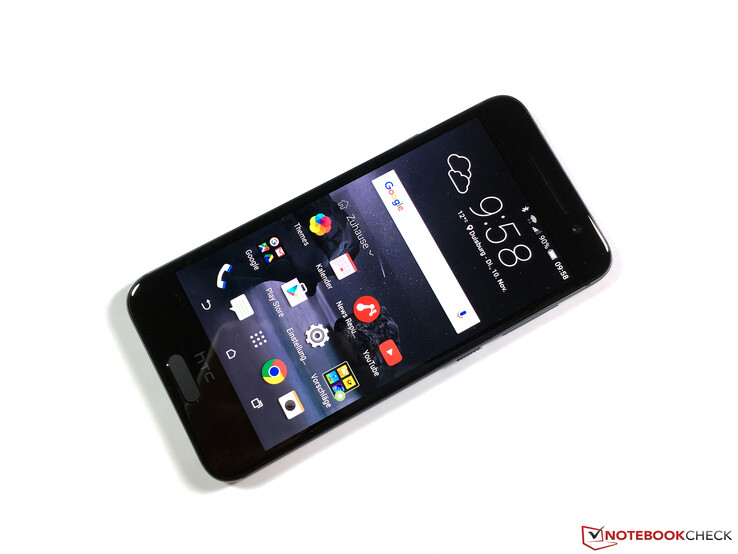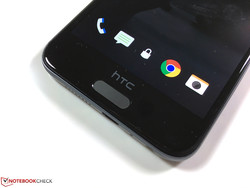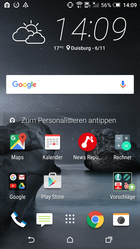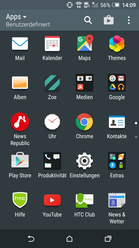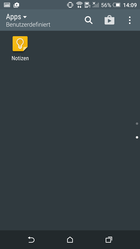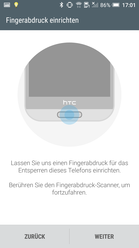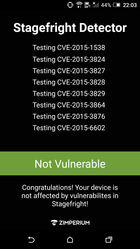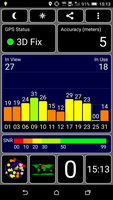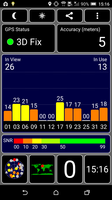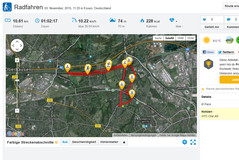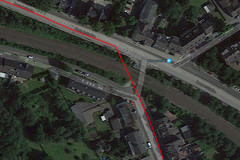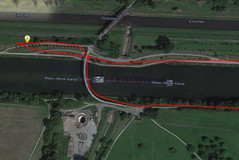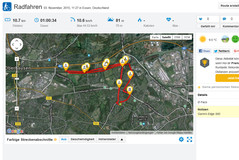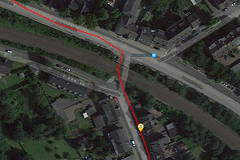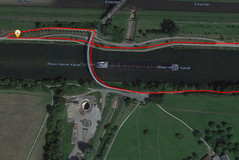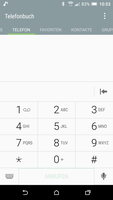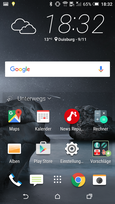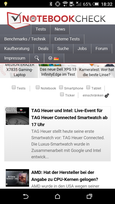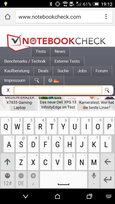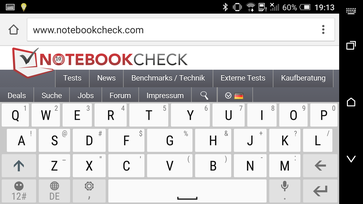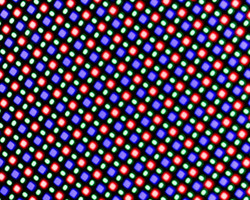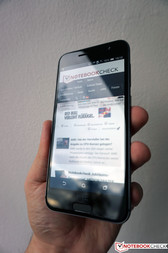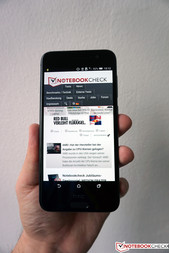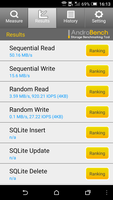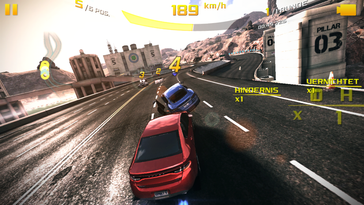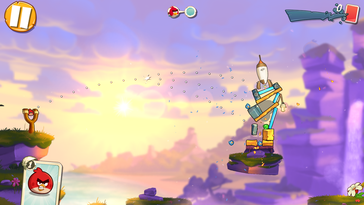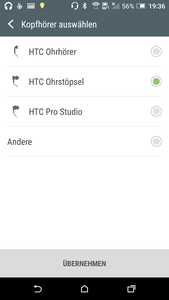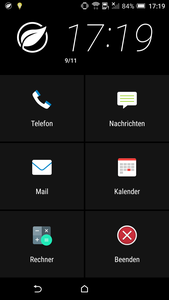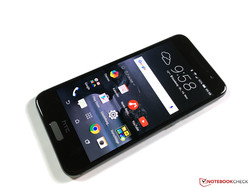HTC One A9 Smartphone Review

For the original German review, see here.
Unlike the smartphones from HTC’s M-series (M9 here in review), the new One A9 from HTC has a greater focus on the design. However, the M-series continues to remain as the technological leader from the Taiwanese manufacturer. This is confirmed in view of the specifications, because a Snapdragon 617 SoC, Adreno 405 GPU and 2 GB of RAM are at least on paper, clearly inferior to the top-class competition. Because of the design, there will also be comparisons with the current iPhones from Apple.
With an RRP of 599 Euros (~$639), the 5-inch HTC One A9 has to face some high-quality products. Examples are the Huawei P8 or the brand-new Sony Xperia Z5 Compact, but the Samsung Galaxy S6 and the Apple iPhone 6 are also in the price range of the new One A9. There is also a strong rival from HTC with the One M9. How many compromises do you have to make in terms of performance and can the high price be justified by the design?
Case
HTC uses a metal unibody chassis. After the release of the first product images, there were obviously comparisons with the current iPhones from Apple. There are certainly many similarities, but you will quickly notice some differences when you actually use them side by side. The smartphone from HTC uses a different material and the surface on the sides in particular is much smoother compared to the iPhone. The radii of the sides are also larger and the transition to the display is "harder". This will result in a different feel when you hold the two devices in the hand. From an objective point of view, it is hard to tell which design is better; you should probably try both and decide for yourself.
The build quality of the HTC One A9 is impeccable and does not have to hide behind the smartphone from Apple. The chassis is very sturdy and cannot be twisted or pushed in, and creaking noises are not an issue for the device. One thing that could be improved, however, is the power button. It does have a ribbed surface to differentiate from the volume rocker, but the pressure point and therefore the feedback is too spongy. Because of the narrow power button, you also notice how much space is wasted underneath the display. There would have been enough room for a speaker similar to the HTC One M9. The camera lens at the back is slightly protruding, but due to the central positioning, the smartphone sits pretty comfortably on a hard surface. On the left side of the chassis are the two (separate) slots for Nano-SIM cards and microSD-cards.
The wide frame above and below the display contribute to the comparatively large dimensions. Despite the smaller 5-inch screen, the HTC One A9 is actually the longest device in this comparison. In addition to the "Carbon Gray" of our review unit, HTC also offers the smartphone in the colors "Opal Silver", "Deep Garnet" (dark red), "Topaz Gold" and "Cast Iron". The latter does not only have a different color, but also a different surface structure.
Connectivity
At the bottom is a Micro-USB port that can be used for charging and data transfers with a computer. It only supports the slower USB 2.0 standard, but also MHL 2.0 for the playback of pictures and videos via TVs or displays. USB-OTG also works and we had no problems using a USB flash drive with the HTC One A9. The 3.5 mm stereo jack is situated next to the USB port.
On the left side of the case are two separate slots for microSD-cards and Nano-SIM cards however, a dual-SIM operation is not possible. You can expand the 16 GB internal storage by up to 2 TB via microSD-card. Apps can also be transferred to the SD-card, but you will have to format it as internal storage first. This also means that you can only use this card in combination with the smartphone since the contents are encrypted. After the initial set-up, you can use around 9.8 GB, but you will lose another 600 MB after all the preloaded apps were updated.
The home button is integrated as a sensor button and includes the fingerprint scanner. Thanks to the slight depression, it is easy to find the sensor with the finger and the scan of the fingerprint works very quickly and reliably. Five different fingerprints can be stored.
Software
The HTC One A9 is shipped with the new operating system, Google Android 6.0 Marshmallow. HTC has also installed its own user interface HTC Sense (7.0), which follows the current material design of the operating system. However, there are no dramatic changes and the UI is very easy to use. It is also possible to customize it comprehensively. A swipe gesture to the right launches the Newsfeed, which shows news from different categories (customizable). There is also a handy widget on the home screen that can show different apps according to your location (Home, Work, On the road) based on Wi-Fi and GPS information. Overall, the manufacturer is pretty restrained in terms of additional software. Apart from the usual Google apps, the Zoe Video Editor, the app News Republic and a link to the app HTC Club, there are no software additions. HTC does not even provide its own apps for some essential functions like mails, music, or the browser. There is a small notification light above the display, which can be used for different actions like new mail.
Communication & GPS
In addition to GSM quad-band and UMTS quad-band (downstream up to 42.2 Mbps, upstream up to 5.76 Mbps), the HTC One A9 can establish Internet connections via LTE Cat. 6. The maximum download speed is up to 300 Mbps (uploads up to 50 Mbps) if the provider supports it. The signal quality was very good in our review in the metropolitan T-Mobile network. We were able to use 4G in almost all situations, while our concurrently used iPhone 6S sometimes used Edge. The integrated Wi-Fi module supports the 802.11 standards a/b/g/n/ac in 2.4 as well as 5 GHz networks. During our test, we did not encounter any problems with two different routers (Fritz!Box and Asus RT-AC56U). Wireless data transfer between two devices is possible via Bluetooth 4.1 and NFC.
The position of the smartphone can be located via A-GPS and the Russian GLONASS. The initial satellite fix takes about 20 seconds outdoors and the location is accurate down to 5 meters (~16 ft). The location fix is also possible indoors close to a window with similar accuracy. We compared the results of the HTC One A9 with the professional navigation device Garmin Edge 500 on a bicycle ride. In the main, the performance is very good because the overall deviation is just 90 meters (~295 ft). However, it should be noted that the One A9 does not review the position as frequently, which can sometimes result in shortcuts. However, there should not be any restrictions when used for navigation in a car or on a bike.
Telephone & Voice Quality
The large number pad dominates the phone app. You also get direct access to the favorites, contacts, groups and caller lists. The One A9 left a good impression during calls. There was no annoying static and the understandability was always very good. However, the microphone has some issues with wind noise, so there is room for improvements. The supplied headset works well and has a small remote to accept calls. On the other hand, the hands-free feature via the single speaker at the bottom distorts quickly and can be easily covered by the hand.
Cameras & Multimedia
A 4 MP UltraPixel camera is installed on the front of the HTC One A9. The module is not different from the HTC One M9 and takes pictures with up to 2688x1520 pixels (16:9) and videos in Full HD (1920x1080). The camera takes decent pictures, even when lighting conditions are not perfect. However, due to the absence of a flash, the results are not that impressive in low-light conditions.
The most interesting change is at the back, because unlike the One M9 (20 MP), HTC has equipped the One A9 with a 13 MP camera including an optical image stabilizer. The default resolution is 10 MP (4208x2368 pixels, 16:9), the full resolution of 13 MP is only available for 4:3 pictures (4208x3120 pixels). The camera app provides various modes, each with its own options. The Pro mode is particularly interesting since many settings (like exposure, ISO) can be adjusted. It is also possible to store the pictures as RAW-files to be edited later on a computer. There are also modes for selfies, panoramas, time lapses and slow motions, but at just 1024x576 pixels, the quality of the latter is rather disappointing. The pictures can either be stored on the internal storage or – which is recommended for RAW files in particular (~25 MB/s) – on the microSD-card.
The 13 MP camera leaves a much better impression than the 20 MP camera of the M9. The results show many details and rich colors in all scenes except for the low-light situation, even though the sharpness of the pictures could be better. The flash works very well at a short distance, but the camera takes much longer (around 2 seconds) in this case, and even slightly longer in the Pro mode.
The camera now has an optical image stabilizer, but the maximum resolution of videos is only Full HD (1920x1080 pixels). On the other hand, high-resolution 4K recordings are not possible. Recordings can be paused to take screenshots, but the resolution can only be adjusted in the settings. In sufficient light conditions, the video quality is good and fast movements are not an issue, but picture noise can quickly develop in darker environments. Nevertheless, the camera is an improvement over that of the One M9.
Accessories
The scope of delivery for the One A9 includes a modular power adaptor, a USB cable, a SIM tool and a quick-start guide. The manufacturer also includes a decent headset, which we will have a closer look at in the Speakers section.
There are some interesting accessories for the One A9. Apart from several headphones and protective cases, the most interesting items are the Dot View Ice cover ($50) as well as the Rapid Charger ($35).
Warranty
The standard warranty period of the HT One A9 is 24 months and cannot be extended.
Input Devices & Handling
The keyboard of the HTC One A9, HTC Sense Input, offers the usual features such as word predictions and Swype inputs (have to be activated in the settings first). Other models from the Play Store are also available. The capacitive touchscreen provides good gliding capabilities and thanks to the rounded edges, gestures from the side work well.
HTC uses on-screen Android buttons, which means that part of the display is not available in all the apps. This is particularly annoying in the browser, where the buttons and the status bar are constantly visible (see pictures below). The handling is very smooth and we did not notice any stutters.
Display
The HTC One A9 uses a 5-inch AMOLED screen with the Full HD resolution of 1920x1080 pixels. This results in a pixel density of 440 PPI, so individual pixels are not visible at a normal viewing distance. Some rivals already feature higher resolutions, but Full HD is still more than sufficient for sharp images.
AMOLED panels are usually at a disadvantage compared to LCD rivals in terms of maximum brightness. This is also the case for the HTC One A9, but an average of 350 cd/m² with the deactivated light sensor is not a bad result. The disadvantage is also more than compensated by the contrast ratio, which is infinite in theory thanks to the black value of 0.0 cd/m². We measured a maximum of 486 cd/m² with the automatic brightness control via sensor on a pure white picture. We also measured the luminance with an even distribution of bright and dark contents (APL 50). The result is 431 cd/m², but the black value is still 0.0 cd/m². The subjective picture impression is very good: Colors are very rich, which is typical of AMOLED screens and the picture is very vivid. There is also a sRGB option if you prefer colors that are more natural.
| |||||||||||||||||||||||||
Brightness Distribution: 93 %
Center on Battery: 346 cd/m²
Contrast: ∞:1 (Black: 0 cd/m²)
ΔE Color 1.55 | 0.5-29.43 Ø5
ΔE Greyscale 2.05 | 0.57-98 Ø5.3
Gamma: 2.15
| HTC One A9 Adreno 405, 617 MSM8952, 16 GB eMMC Flash | Huawei P8 Mali-T628 MP4, Kirin 930, 16 GB eMMC Flash | HTC One M9 Adreno 430, 810 MSM8994, 32 GB eMMC Flash | Sony Xperia Z5 Compact Adreno 430, 810 MSM8994, 32 GB eMMC Flash | Samsung Galaxy S6 Mali-T760 MP8, Exynos 7420, 32 GB UFS 2.0 Flash | Apple iPhone 6 PowerVR GX6450, A8, 128 GB eMMC Flash | |
|---|---|---|---|---|---|---|
| Screen | -59% | -92% | -115% | -19% | -35% | |
| Brightness middle | 346 | 453 31% | 474 37% | 547 58% | 335 -3% | 520 50% |
| Brightness | 349 | 439 26% | 458 31% | 532 52% | 345 -1% | 511 46% |
| Brightness Distribution | 93 | 91 -2% | 85 -9% | 94 1% | 89 -4% | 88 -5% |
| Black Level * | 0.28 | 0.4 | 0.54 | 0.61 | ||
| Colorchecker dE 2000 * | 1.55 | 4.7 -203% | 6.32 -308% | 7.37 -375% | 2.51 -62% | 3.92 -153% |
| Greyscale dE 2000 * | 2.05 | 5.03 -145% | 6.36 -210% | 8.39 -309% | 2.59 -26% | 4.33 -111% |
| Gamma | 2.15 102% | 2.27 97% | 2.43 91% | 2.28 96% | 2.43 91% | 2.46 89% |
| CCT | 6267 104% | 7439 87% | 8218 79% | 9074 72% | 6424 101% | 7384 88% |
| Contrast | 1618 | 1185 | 1013 | 852 | ||
| Color Space (Percent of AdobeRGB 1998) | 72.04 | 58.81 | ||||
| Color Space (Percent of sRGB) | 99.9865 |
* ... smaller is better
We used the professional software CalMAN for an objective analysis and compare the two available color profiles AMOLED and sRGB. Even the default AMOLED profile manages decent results and the average deviations compared to the sRGB color space are 4.85 (ColorChecker) and 2.76 (Grayscale), respectively. The gamma value is perfect at 2.2 and the color temperature of 6673 K (ideal: 6500 K) is just a tad too cool. The performance of the sRGB mode is even better. The gamma value is slightly worse at 2.15 and the color temperature is now a bit too warm at 6267 K, but the average DeltaE deviations for the colors and the grayscale drop to just 1.55 and 2.05, respectively (target value smaller than 3). These are excellent results and significantly better than the rivals.
Thanks to the excellent contrast ratio and the high brightness, the HTC One A9 works very well in the outdoors. Even with direct reflections, the screen contents can be recognized and there are absolutely no restrictions without those reflections or in the shade. The viewing angle stability of the AMOLED panel is excellent. The content is perfectly visible from all directions without any apparent contrast or brightness loss.
Performance
HTC has equipped the new One A9 with a Qualcomm Snapdragon 617 SoC. The processor with 64-bit support consists of eight Cortex-A53 cores, which are divided into two clusters of four cores each. One cluster can reach up to 1.5 GHz, while the second cluster runs at up to 1.2 GHz. The graphics calculations are handled by the Adreno 405 GPU, which is also provided by Qualcomm. The SoC is supported by 2 GB of memory. These components already show that HTC acts conservatively and does not aim for the performance crown. We have also included the Allview X2 Soul Pro (~400 Euros/~$426) in the benchmarks, because its MediaTek MT6752 SoC (1.7 GHz) should provide roughly the same performance.
This is supported by the synthetic benchmarks, where the review sample is usually at the bottom of the rankings within our comparison group. The differences are sometimes very clear, but the subjective impression of the review unit is positive. We have already mentioned that the handling of the smartphone is always smooth and we could not determine any stutters. A look at our database shows that the Snapdragon 617 (1.5 GHz) is actually on par with the Snapdragon 615 (1.7 GHz), which is used in many mainstream smartphones.
The graphics card Adreno 405 is also at the bottom of the charts in the 3DMarks. Our review unit can only compete with the Allview X2 Soul Pro in the more demanding tests with OpenGL ES 3.0 or 3.1, the other rivals are sometimes twice or three times as fast. We will see the impacts on the gaming performance later.
| AnTuTu v5 - Total Score (sort by value) | |
| HTC One A9 | |
| Huawei P8 | |
| HTC One M9 | |
| Sony Xperia Z5 Compact | |
| Samsung Galaxy S6 | |
| Apple iPhone 6 | |
| Allview X2 Soul Pro | |
| Geekbench 3 | |
| 32 Bit Multi-Core Score (sort by value) | |
| Huawei P8 | |
| HTC One M9 | |
| Sony Xperia Z5 Compact | |
| Samsung Galaxy S6 | |
| Apple iPhone 6 | |
| 32 Bit Single-Core Score (sort by value) | |
| Huawei P8 | |
| HTC One M9 | |
| Sony Xperia Z5 Compact | |
| Samsung Galaxy S6 | |
| Apple iPhone 6 | |
| 64 Bit Multi-Core Score (sort by value) | |
| HTC One A9 | |
| Huawei P8 | |
| HTC One M9 | |
| Allview X2 Soul Pro | |
| 64 Bit Single-Core Score (sort by value) | |
| HTC One A9 | |
| Huawei P8 | |
| HTC One M9 | |
| Allview X2 Soul Pro | |
| GFXBench (DX / GLBenchmark) 2.7 | |
| T-Rex Onscreen (sort by value) | |
| HTC One A9 | |
| Huawei P8 | |
| HTC One M9 | |
| Sony Xperia Z5 Compact | |
| Samsung Galaxy S6 | |
| Apple iPhone 6 | |
| Allview X2 Soul Pro | |
| 1920x1080 T-Rex Offscreen (sort by value) | |
| HTC One A9 | |
| Huawei P8 | |
| HTC One M9 | |
| Sony Xperia Z5 Compact | |
| Samsung Galaxy S6 | |
| Apple iPhone 6 | |
| Allview X2 Soul Pro | |
| GFXBench 3.0 | |
| on screen Manhattan Onscreen OGL (sort by value) | |
| HTC One A9 | |
| Huawei P8 | |
| HTC One M9 | |
| Sony Xperia Z5 Compact | |
| Samsung Galaxy S6 | |
| Apple iPhone 6 | |
| Allview X2 Soul Pro | |
| 1920x1080 1080p Manhattan Offscreen (sort by value) | |
| HTC One A9 | |
| Huawei P8 | |
| HTC One M9 | |
| Sony Xperia Z5 Compact | |
| Samsung Galaxy S6 | |
| Apple iPhone 6 | |
| Allview X2 Soul Pro | |
| GFXBench 3.1 | |
| on screen Manhattan ES 3.1 Onscreen (sort by value) | |
| HTC One A9 | |
| HTC One M9 | |
| Sony Xperia Z5 Compact | |
| 1920x1080 Manhattan ES 3.1 Offscreen (sort by value) | |
| HTC One A9 | |
| HTC One M9 | |
| Sony Xperia Z5 Compact | |
| PCMark for Android - Work performance score (sort by value) | |
| HTC One A9 | |
| Huawei P8 | |
| HTC One M9 | |
| Sony Xperia Z5 Compact | |
| Smartbench 2012 | |
| Gaming Index (sort by value) | |
| HTC One A9 | |
| Huawei P8 | |
| HTC One M9 | |
| Sony Xperia Z5 Compact | |
| Allview X2 Soul Pro | |
| Productivity Index (sort by value) | |
| HTC One A9 | |
| Huawei P8 | |
| HTC One M9 | |
| Sony Xperia Z5 Compact | |
| Allview X2 Soul Pro | |
| BaseMark OS II | |
| Web (sort by value) | |
| HTC One A9 | |
| Huawei P8 | |
| HTC One M9 | |
| Sony Xperia Z5 Compact | |
| Apple iPhone 6 | |
| Allview X2 Soul Pro | |
| Graphics (sort by value) | |
| HTC One A9 | |
| Huawei P8 | |
| HTC One M9 | |
| Sony Xperia Z5 Compact | |
| Apple iPhone 6 | |
| Allview X2 Soul Pro | |
| Memory (sort by value) | |
| HTC One A9 | |
| Huawei P8 | |
| HTC One M9 | |
| Sony Xperia Z5 Compact | |
| Apple iPhone 6 | |
| Allview X2 Soul Pro | |
| System (sort by value) | |
| HTC One A9 | |
| Huawei P8 | |
| HTC One M9 | |
| Sony Xperia Z5 Compact | |
| Apple iPhone 6 | |
| Allview X2 Soul Pro | |
| Overall (sort by value) | |
| HTC One A9 | |
| Huawei P8 | |
| HTC One M9 | |
| Sony Xperia Z5 Compact | |
| Apple iPhone 6 | |
| Allview X2 Soul Pro | |
| Linpack Android / IOS | |
| Multi Thread (sort by value) | |
| HTC One A9 | |
| Huawei P8 | |
| HTC One M9 | |
| Sony Xperia Z5 Compact | |
| Apple iPhone 6 | |
| Allview X2 Soul Pro | |
| Single Thread (sort by value) | |
| HTC One A9 | |
| Huawei P8 | |
| HTC One M9 | |
| Sony Xperia Z5 Compact | |
| Apple iPhone 6 | |
| Allview X2 Soul Pro | |
All the browser-based tests were performed with the preloaded Google Chrome 46.0. The HTC One A9 is often in the last place and is usually just beaten by the Allview X2 Soul Pro. However, we can reiterate our impressions from the last paragraph that subjectively, the review unit feels fast enough and there are no restrictions.
| Sunspider - 1.0 Total Score (sort by value) | |
| HTC One A9 | |
| Huawei P8 | |
| HTC One M9 | |
| Sony Xperia Z5 Compact | |
| Samsung Galaxy S6 | |
| Apple iPhone 6 | |
| Allview X2 Soul Pro | |
| Octane V2 - Total Score (sort by value) | |
| HTC One A9 | |
| Huawei P8 | |
| HTC One M9 | |
| Sony Xperia Z5 Compact | |
| Samsung Galaxy S6 | |
| Apple iPhone 6 | |
| Allview X2 Soul Pro | |
| Mozilla Kraken 1.1 - Total (sort by value) | |
| HTC One A9 | |
| Huawei P8 | |
| HTC One M9 | |
| Sony Xperia Z5 Compact | |
| Apple iPhone 6 | |
| Allview X2 Soul Pro | |
| Google V8 Ver. 7 - Google V8 Ver. 7 Score (sort by value) | |
| HTC One A9 | |
| Huawei P8 | |
| HTC One M9 | |
| Sony Xperia Z5 Compact | |
| Apple iPhone 6 | |
| WebXPRT 2015 - Overall (sort by value) | |
| HTC One A9 | |
| Huawei P8 | |
| HTC One M9 | |
| Sony Xperia Z5 Compact | |
| JetStream 1.1 - Total Score (sort by value) | |
| HTC One A9 | |
| HTC One M9 | |
| Sony Xperia Z5 Compact | |
| Samsung Galaxy S6 | |
| Allview X2 Soul Pro | |
* ... smaller is better
The 16 GB eMMC internal storage is average in the benchmarks. We measured almost 190 MB/s for sequential reads for the HTC One A9, which is enough to beat the two devices Huawei P8 and Allview X2 Soul Pro. Our review unit cannot keep up with the other three flagship devices HTC One M9, Samsung Galaxy S6 and Sony Xperia Z5 Compact (235 – 319 MB/s). All other tests show the One A9 in the last place.
We checked the performance of the microSD-slot in combination with the Toshiba Exceria SD-CX32UHS1 memory card. With 50 MB/s reading and 15 MB/s writing, the full potential of the card cannot be utilized. This will affect larger copy processes or the storing of RAW pictures on the memory card, which can take longer and delay the time before you can take the next picture.
| AndroBench 3-5 | |
| Sequential Read 256KB (sort by value) | |
| HTC One A9 | |
| Huawei P8 | |
| HTC One M9 | |
| Sony Xperia Z5 Compact | |
| Samsung Galaxy S6 | |
| Allview X2 Soul Pro | |
| Sequential Write 256KB (sort by value) | |
| HTC One A9 | |
| Huawei P8 | |
| HTC One M9 | |
| Sony Xperia Z5 Compact | |
| Samsung Galaxy S6 | |
| Allview X2 Soul Pro | |
| Random Read 4KB (sort by value) | |
| HTC One A9 | |
| Huawei P8 | |
| HTC One M9 | |
| Sony Xperia Z5 Compact | |
| Samsung Galaxy S6 | |
| Allview X2 Soul Pro | |
| Random Write 4KB (sort by value) | |
| HTC One A9 | |
| Huawei P8 | |
| HTC One M9 | |
| Sony Xperia Z5 Compact | |
| Samsung Galaxy S6 | |
| Allview X2 Soul Pro | |
Games
The graphics card Adreno 405 has a core clock of 550 MHz and is the smallest chip from Qualcomm's Adreno 400-series. The results in the benchmarks have already demonstrated that the review unit clearly falls behind the rivals and there can be restrictions when you play games that are more demanding. For example, in the racing game “Asphalt 8: Airborne” as soon as medium or high detail setting is selected stutters can be noticed. It will only run smoothly at low settings. Simpler games like “Angry Birds 2” are not a problem, but you have to expect limitations in the long term. The sensors and the touchscreen work well and do not affect the gaming experience.
Emissions
Temperature
Because of the lower performance, we expected a pretty cool device. This is only true while idling or under light workloads where the average temperatures are at 28 °C (~82 °F) at the front and the back. The smartphone does get really warm in the upper half and up to 41 °C (~106 °F) are clearly perceptible. These maximum temperatures were determined during our impractical stress test, but the smartphone also gets very warm during gaming – too warm for the performance.
We checked the performance of the components under sustained load with the GFXBench Battery Test. While the T-Rex Test is repeated thirty times, the app logs the performance and the temperatures. The performance curve might look rather wild in the diagram, but the differences between the individual runs are within 1%, so there is no throttling.
(±) The maximum temperature on the upper side is 41.3 °C / 106 F, compared to the average of 35 °C / 95 F, ranging from 21.9 to 56 °C for the class Smartphone.
(+) The bottom heats up to a maximum of 39.8 °C / 104 F, compared to the average of 33.8 °C / 93 F
(+) In idle usage, the average temperature for the upper side is 28.4 °C / 83 F, compared to the device average of 32.7 °C / 91 F.
Speakers
With the new chassis design, HTC has also dispensed with the two stereo speakers at the front. The new One A9 only has one speaker on the lower edge. Therefore, it cannot keep up with the One M9, but the small module is still pretty loud and you can also listen to it at maximum volume. Bass on the other hand is not available and there are no software enhancements. The HTC BoomSound with Dolby Audio can be used only when the headphones are attached. There are not many settings though, because you can only activate it and select a profile for HTC headphones or "Others" (see screenshot). The result is a slightly richer sound, which is particularly audible with less expensive headphones. High-quality models on the other hand, reveal distortions but thanks to the integrated DA converter, the software can be deactivated. The supplied in-ear headset is one of the better additions on the market and includes different tips for the ears. Another advantage of the headset is the flat cable, so you cannot twist it. All in all, the sound output of the 3.5 mm jack is really good and sufficiently loud.
If you want the playback to be even louder, you can obviously connect external speakers. This is possible via stereo jack, Google Cast or Bluetooth. A connection with the Bluetooth speaker Denon Envaya Mini worked without any problems; we noticed dropouts only when the distance was more than 10 meters (incl. two walls/~33 ft).
Energy Management
Power Consumption
The power consumption of the HTC One A9 is average and often better compared to the rivals, which however, is not surprising considering the lower performance. That there is still room for improvements is obvious when you look at the idle measurements of the Samsung Galaxy S6 or the similarly powerful Allview X2 Soul Pro. HTC ships the smartphone with a modular 7.5-watt (5 V, 1.5 A) power adaptor, which is powerful enough for the maximum consumption of almost 6 watts.
| Off / Standby | |
| Idle | |
| Load |
|
| HTC One A9 Adreno 405, 617 MSM8952, 16 GB eMMC Flash | Huawei P8 Mali-T628 MP4, Kirin 930, 16 GB eMMC Flash | HTC One M9 Adreno 430, 810 MSM8994, 32 GB eMMC Flash | Sony Xperia Z5 Compact Adreno 430, 810 MSM8994, 32 GB eMMC Flash | Samsung Galaxy S6 Mali-T760 MP8, Exynos 7420, 32 GB UFS 2.0 Flash | Apple iPhone 6 PowerVR GX6450, A8, 128 GB eMMC Flash | Allview X2 Soul Pro Mali-T760 MP2, MT6752, 16 GB eMMC Flash | |
|---|---|---|---|---|---|---|---|
| Power Consumption | -30% | -55% | -17% | 15% | 6% | 12% | |
| Idle Minimum * | 0.9 | 0.7 22% | 1.1 -22% | 0.6 33% | 0.4 56% | 0.3 67% | 0.7 22% |
| Idle Average * | 1.2 | 2 -67% | 2 -67% | 1.4 -17% | 0.6 50% | 1.5 -25% | 1.1 8% |
| Idle Maximum * | 1.4 | 2.1 -50% | 2.4 -71% | 1.7 -21% | 1.2 14% | 2 -43% | 1.4 -0% |
| Load Average * | 3.8 | 4.9 -29% | 7.2 -89% | 5.3 -39% | 5 -32% | 3.1 18% | 2.8 26% |
| Load Maximum * | 5.9 | 7.4 -25% | 7.5 -27% | 8.4 -42% | 6.8 -15% | 5.2 12% | 5.7 3% |
* ... smaller is better
Battery Runtime
The lithium-polymer battery of the HTC One A9 has a capacity of 8.17 Wh (2150 mAh). All other Android rivals offer much more (at least 2550 mAh @Samsung Galaxy S6), only the Apple iPhone 6 has an even smaller battery (1810 mAh). Considering the average consumption values, we do not expect any new runtime records.
We used a Wi-Fi reading script at the minimum brightness to determine maximum runtime. The HTC One A9 manages slightly more than 19 hours in this scenario, which is an average result within our comparison group. At the other extreme, the minimum runtime is simulated by the app Stability Test at the highest brightness. Our review sample ran for almost 3 hours and can only beat the Apple iPhone 6 (2:08 h) and the Allview X2 Soul Pro (2:45 h), some of the other Android smartphones have much more stamina despite the higher performance (+22 up to +58 %).
Maximum load or full idle is not very common in practice, which is why our Wi-Fi test at an adjusted brightness of 150 cd/m² is more interesting. Once again, a result of just six hours confirms the small battery of the HTC One A9, because all the other rivals except for the HTC One M9 manage better results. This situation is also confirmed in the video test, where we run a loop of the quick movie Big Buck Bunny (1080p, H.264) at 150 cd/m². 7 hours and 45 minutes is not a bad result, but once again, the competition is more enduring.
HTC has implemented two different energy-saving modes to increase the runtime if necessary. The normal energy-saving mode (can be automatically activated at 5 or 15% remaining capacity) reduces the CPU usage, limits location services, reduces the display brightness and deactivates the tactile vibration feedback. The other mode is the extreme energy-saving mode, which can also be automatically activated at different capacities. This mode really limits the functionality of the smartphone; you can only make calls, use messages, mails, the calendar, the calculator and the watch (see screenshot).
The HTC One A9 supports Qualcomm’s Quick Charge technology (2.0), but you will need a special power adaptor. HTC offers the optional Rapid Charger for $35. According to HTC quick charge 3.0 will be available soon, but it will probably require another power adaptor. The supplied 7.5-watt PSU needs almost two hours for a full charge when the device is turned on.
| HTC One A9 Adreno 405, 617 MSM8952, 16 GB eMMC Flash | Huawei P8 Mali-T628 MP4, Kirin 930, 16 GB eMMC Flash | HTC One M9 Adreno 430, 810 MSM8994, 32 GB eMMC Flash | Sony Xperia Z5 Compact Adreno 430, 810 MSM8994, 32 GB eMMC Flash | Samsung Galaxy S6 Mali-T760 MP8, Exynos 7420, 32 GB UFS 2.0 Flash | Apple iPhone 6 PowerVR GX6450, A8, 128 GB eMMC Flash | Allview X2 Soul Pro Mali-T760 MP2, MT6752, 16 GB eMMC Flash | |
|---|---|---|---|---|---|---|---|
| Battery Runtime | 9% | -3% | 42% | 33% | 7% | 16% | |
| Reader / Idle | 1154 | 826 -28% | 805 -30% | 2249 95% | 1300 13% | 1369 19% | |
| H.264 | 465 | 581 25% | 421 -9% | 525 13% | 595 28% | ||
| WiFi v1.3 | 368 | 434 18% | 348 -5% | 440 20% | 475 29% | 507 38% | |
| Load | 176 | 215 22% | 236 34% | 242 38% | 278 58% | 128 -27% | 165 -6% |
| WiFi | 573 | 575 | 530 |
Pros
Cons
Verdict
The HTC One A9 is a new approach for the Taiwanese manufacturer. The focus of the new smartphone is clearly on the design. Despite the big similarities to the current iPhones from Apple, it would not be fair to say that the One A9 is just an iPhone clone. Actually, the handling is very different between the two models, but the build quality is on a similarly high level. Other advantages of the review unit are the good camera and the excellent display.
The biggest issue is the performance. The smartphone does not seem too slow in practice when you browse the web, watch YouTube videos or write mails, but there will be limitations when you play current games. We would have also expected that the lower performance has a positive effect on the temperatures and the battery runtimes, but unfortunately, this is not the case.
The HTC One A9 does have a great chassis, but this is also true of other Android rivals like the Samsung Galaxy S6 or the HTC One M9. Those devices also provide significantly more performance for the same price.
With an RRP of 599 Euros (~$638/current street price around 550 Euros/~$585), the HTC One A9 has to face high-end competitors that also offer great cases (sometimes metal) and have a clear advantage in terms of performance. The One A9 is a good smartphone in some respects, but we cannot recommend it for the current price. We are eager to see if HTC will implement some of the improvements (like the camera or the slimmed down HTC Sense) for the upcoming One M10, which will probably have no issues with performance.
HTC One A9
-
11/11/2015 v4(old)
Andreas Osthoff


 Deutsch
Deutsch English
English Español
Español Français
Français Italiano
Italiano Nederlands
Nederlands Polski
Polski Português
Português Русский
Русский Türkçe
Türkçe Svenska
Svenska Chinese
Chinese Magyar
Magyar